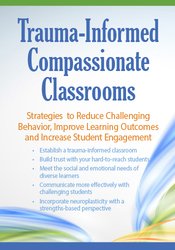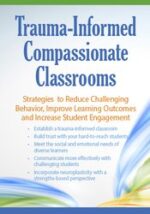As an educator, you are faced with the challenge of meeting the social and emotional needs of all your students. This can be challenging enough with typical learners but it is even more difficult with those who have experienced trauma or have mental health challenges.
Jennifer L. Bashant – Trauma Informed Compassionate Classrooms
Trauma in Students: What to Look For
Fight, flight or freeze responses: How it manifests in school
Wired for fear: Impact on the whole child
ACEs – Adverse Childhood Experiences study and survey
The role of poverty and mental health challenges
Trauma Therapy
Benefits
Limitations of the Research
Potential Risks
Discipline in a Trauma-Informed Classroom
Changing your mindset: Punitive vs. collaborative
Strategies to foster intrinsic motivation
3 steps to implement a collaborative approach
Case study: How you respond
Neuroplasticity: Activities to Establish & Strengthen Neural Pathways
Strategies to develop new ways of responding
Slow down, stop and think
Respond rather than react
Social stories
Techniques to incorporate the 4 R’s:
Rhythmic
Repetitive
Relational
Rewarding
Relationships as a Protective Factor
Techniques to form positive relationships and increase students’ likeliness to:
Stay in school longer
Work harder
Increase test scores & grades
Increase their self-confidence
Techniques to help students feel connected to school making them less likely to:
Smoke or drink
Have sexual intercourse
Develop emotional problems
Experience suicidal thoughts or attempts
Carry weapons
Be involved in violence or dangerous activities
Case study: Strengths-based, solution-focused approach
Mindfulness and Self-Awareness Activities To:
Help with transitions
Reduce impulsive behaviors
Strengthen empathy, kindness and compassion
Calm and focus attention
Social and Emotional Learning Techniques to Increase:
Focus and concentration
Impulse control
Conflict resolution skills
Mindful Communication Tools to Improve Student Engagement
Lead with presence
Attention
Intention
Mindful Strategies to Increase Connection, Empathy & Community
Gratitude
Heartfulness
Zones of Regulation to Teach Self-Awareness & Emotional Control
Red zone
Yellow zone
Green zone
Blue zone
Would you like to receive Jennifer L. Bashant – Trauma Informed Compassionate Classrooms ?
Description:
As an educator, you are faced with the challenge of meeting the social and emotional needs of all your students. This can be challenging enough with typical learners but it is even more difficult with those who have experienced trauma or have mental health challenges. Students who have experienced trauma often present as difficult to engage and display problematic behavior such as a low frustration tolerance, angry outbursts or difficult social relationships. These behaviors all get in the way of teaching and learning. When a student has experienced trauma, he/she often spends much of the day in fight/flight/freeze mode which limits their capacity to learn. Their outwardly aggressive and irritable behaviors also disrupt the flow in the classroom, requiring your time and attention. Despite the amount of time you invest in behavior charts or incentives for good behavior, traditional behavioral approaches to classroom management and a punitive approach to discipline simply are not effective.
Watch Dr. Bashant and learn how a trauma-informed approach will greatly reduce challenging behavior, improve student engagement and increase learning outcomes. Finish this recording with new strategies, tools and resources to reduce students’ impulsiveness, aggressive behaviors and inattention and increase their focus, attention and compassion. While this positive approach is absolutely essential for students with trauma, it will also greatly benefit each and every student in your classroom. Return to your school with:
Research-based practices to establish a trauma-informed classroom
A plan to develop positive relationships and build trust with your hard-to-reach students
Prove techniques for communicating more effectively and collaboratively with challenging students
Cognitive skill-building strategies which incorporate the science of neuroplasticity and the strengths-based perspective of neurodiversity








